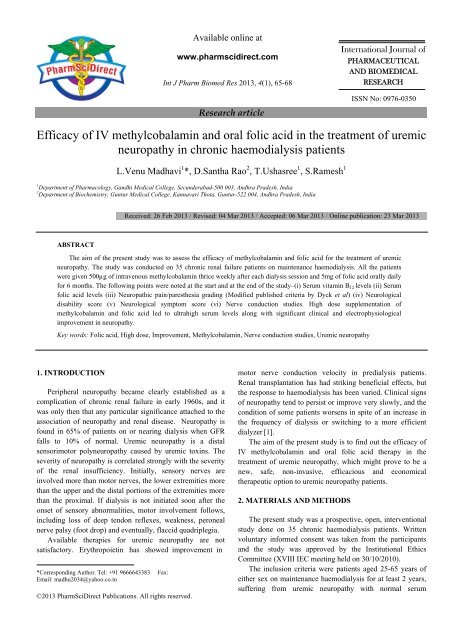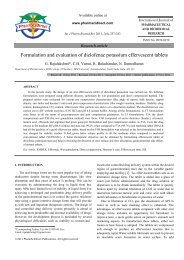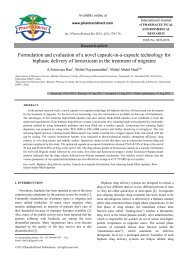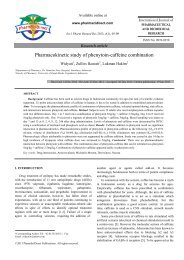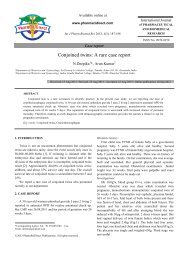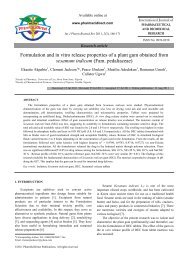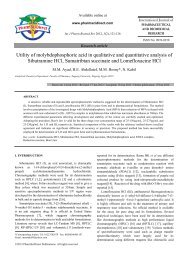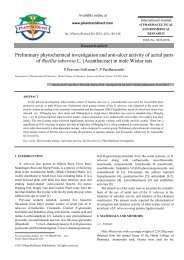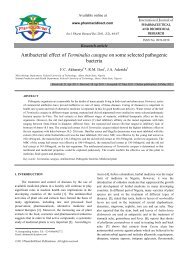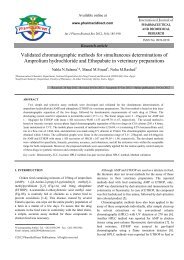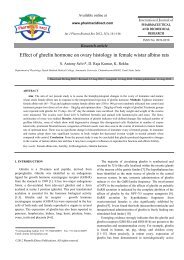Efficacy of IV methylcobalamin and oral folic acid ... - PharmSciDirect
Efficacy of IV methylcobalamin and oral folic acid ... - PharmSciDirect
Efficacy of IV methylcobalamin and oral folic acid ... - PharmSciDirect
- No tags were found...
Create successful ePaper yourself
Turn your PDF publications into a flip-book with our unique Google optimized e-Paper software.
Available online at<br />
www.pharmscidirect.com<br />
Int J Pharm Biomed Res 2013, 4(1), 65-68<br />
Research article<br />
International Journal <strong>of</strong><br />
PHARMACEUTICAL<br />
AND BIOMEDICAL<br />
RESEARCH<br />
ISSN No: 0976-0350<br />
<strong>Efficacy</strong> <strong>of</strong> <strong>IV</strong> <strong>methylcobalamin</strong> <strong>and</strong> <strong>oral</strong> <strong>folic</strong> <strong>acid</strong> in the treatment <strong>of</strong> uremic<br />
neuropathy in chronic haemodialysis patients<br />
L.Venu Madhavi 1 *, D.Santha Rao 2 , T.Ushasree 1 , S.Ramesh 1<br />
1 Department <strong>of</strong> Pharmacology, G<strong>and</strong>hi Medical College, Secunderabad-500 003, Andhra Pradesh, India<br />
2 Department <strong>of</strong> Biochemistry, Guntur Medical College, Kannavari Thota, Guntur-522 004, Andhra Pradesh, India<br />
Received: 26 Feb 2013 / Revised: 04 Mar 2013 / Accepted: 06 Mar 2013 / Online publication: 23 Mar 2013<br />
ABSTRACT<br />
The aim <strong>of</strong> the present study was to assess the efficacy <strong>of</strong> <strong>methylcobalamin</strong> <strong>and</strong> <strong>folic</strong> <strong>acid</strong> for the treatment <strong>of</strong> uremic<br />
neuropathy. The study was conducted on 35 chronic renal failure patients on maintenance haemodialysis. All the patients<br />
were given 500µg <strong>of</strong> intravenous <strong>methylcobalamin</strong> thrice weekly after each dialysis session <strong>and</strong> 5mg <strong>of</strong> <strong>folic</strong> <strong>acid</strong> <strong>oral</strong>ly daily<br />
for 6 months. The following points were noted at the start <strong>and</strong> at the end <strong>of</strong> the study–(i) Serum vitamin B 12 levels (ii) Serum<br />
<strong>folic</strong> <strong>acid</strong> levels (iii) Neuropathic pain/paresthesia grading (Modified published criteria by Dyck et al) (iv) Neurological<br />
disability score (v) Neurological symptom score (vi) Nerve conduction studies. High dose supplementation <strong>of</strong><br />
<strong>methylcobalamin</strong> <strong>and</strong> <strong>folic</strong> <strong>acid</strong> led to ultrahigh serum levels along with significant clinical <strong>and</strong> electrophysiological<br />
improvement in neuropathy.<br />
Key words: Folic <strong>acid</strong>, High dose, Improvement, Methylcobalamin, Nerve conduction studies, Uremic neuropathy<br />
1. INTRODUCTION<br />
Peripheral neuropathy became clearly established as a<br />
complication <strong>of</strong> chronic renal failure in early 1960s, <strong>and</strong> it<br />
was only then that any particular significance attached to the<br />
association <strong>of</strong> neuropathy <strong>and</strong> renal disease. Neuropathy is<br />
found in 65% <strong>of</strong> patients on or nearing dialysis when GFR<br />
falls to 10% <strong>of</strong> normal. Uremic neuropathy is a distal<br />
sensorimotor polyneuropathy caused by uremic toxins. The<br />
severity <strong>of</strong> neuropathy is correlated strongly with the severity<br />
<strong>of</strong> the renal insufficiency. Initially, sensory nerves are<br />
involved more than motor nerves, the lower extremities more<br />
than the upper <strong>and</strong> the distal portions <strong>of</strong> the extremities more<br />
than the proximal. If dialysis is not initiated soon after the<br />
onset <strong>of</strong> sensory abnormalities, motor involvement follows,<br />
including loss <strong>of</strong> deep tendon reflexes, weakness, peroneal<br />
nerve palsy (foot drop) <strong>and</strong> eventually, flaccid quadriplegia.<br />
Available therapies for uremic neuropathy are not<br />
satisfactory. Erythropoietin has showed improvement in<br />
*Corresponding Author. Tel: +91 9666643383<br />
Email: madhu2034@yahoo.co.in<br />
Fax:<br />
©2013 <strong>PharmSciDirect</strong> Publications. All rights reserved.<br />
motor nerve conduction velocity in predialysis patients.<br />
Renal transplantation has had striking beneficial effects, but<br />
the response to haemodialysis has been varied. Clinical signs<br />
<strong>of</strong> neuropathy tend to persist or improve very slowly, <strong>and</strong> the<br />
condition <strong>of</strong> some patients worsens in spite <strong>of</strong> an increase in<br />
the frequency <strong>of</strong> dialysis or switching to a more efficient<br />
dialyzer [1].<br />
The aim <strong>of</strong> the present study is to find out the efficacy <strong>of</strong><br />
<strong>IV</strong> <strong>methylcobalamin</strong> <strong>and</strong> <strong>oral</strong> <strong>folic</strong> <strong>acid</strong> therapy in the<br />
treatment <strong>of</strong> uremic neuropathy, which might prove to be a<br />
new, safe, non-invasive, efficacious <strong>and</strong> economical<br />
therapeutic option to uremic neuropathy patients.<br />
2. MATERIALS AND METHODS<br />
The present study was a prospective, open, interventional<br />
study done on 35 chronic haemodialysis patients. Written<br />
voluntary informed consent was taken from the participants<br />
<strong>and</strong> the study was approved by the Institutional Ethics<br />
Committee (XVIII IEC meeting held on 30/10/2010).<br />
The inclusion criteria were patients aged 25-65 years <strong>of</strong><br />
either sex on maintenance haemodialysis for at least 2 years,<br />
suffering from uremic neuropathy with normal serum
L.Venu Madhavi et al, Int J Pharm Biomed Res 2013, 4(1), 65-68 66<br />
Vitamin B 12 <strong>and</strong> <strong>folic</strong> <strong>acid</strong> levels. Patients with diabetes,<br />
sepsis, leprosy, H<strong>IV</strong>, dialysis related amyloidosis, peripheral<br />
vascular disease, CVA, meningitis, encephalitis, chronic liver<br />
disease, malabsorption syndromes were excluded.<br />
Patients receiving maintenance haemodialysis with<br />
polyneuropathy <strong>and</strong> serum B 12 <strong>and</strong> <strong>folic</strong> <strong>acid</strong> levels in the<br />
normal range were selected based on a) Serum B 12 <strong>and</strong> <strong>folic</strong><br />
<strong>acid</strong> levels b) Clinical assessment <strong>of</strong> sensory <strong>and</strong> motor<br />
neuropathy c) Neuropathic pain/paresthesia grading [2] d)<br />
Neurological disability score [2] e) Neurological symptom<br />
score [3] f) Nerve conduction studies [4].<br />
Patients are given <strong>IV</strong> Methylcobalamin (500µg) 3 times a<br />
week, after each haemodialysis along the dialysis line <strong>and</strong><br />
<strong>oral</strong> <strong>folic</strong> <strong>acid</strong> (5mg) daily for 6 months. At the end <strong>of</strong> 6<br />
months, improvement in neuropathy is assessed by the above<br />
mentioned criteria <strong>and</strong> serum vitamin B 12 <strong>and</strong> <strong>folic</strong> <strong>acid</strong><br />
levels were estimated. The blood samples are collected in<br />
fasting state before initiation <strong>of</strong> dialysis. They are protected<br />
from light <strong>and</strong> stored at 4-8°C, serum separated <strong>and</strong> analyzed<br />
within 4 hrs <strong>of</strong> collection. (Reference ranges: Serum vitamin<br />
B 12 : 200-835pg/mL, Serum <strong>folic</strong> <strong>acid</strong>: 3-20ng/mL) [5,6].<br />
Data is analyzed by using Micros<strong>of</strong>t Excel Sheet <strong>and</strong><br />
Graph Pad Prism s<strong>of</strong>tware, employing paired student t test.<br />
Results are expressed as mean±SEM <strong>and</strong> p value < 0.05 is<br />
considered significant.<br />
28.57<br />
20<br />
%<br />
71.43<br />
Fig.2. Sex distribution<br />
%<br />
2.86<br />
77.14<br />
Fig.3. Duration <strong>of</strong> dialysis<br />
males<br />
females<br />
2‐4 years<br />
5‐7 years<br />
8‐10 years<br />
3. RESULTS<br />
The mean age <strong>of</strong> the study sample is 45.6 (Fig.1) with<br />
majority males (71.43%) (Fig.2). 54.3% <strong>of</strong> patients were<br />
symptomatic. The mean duration <strong>of</strong> dialysis <strong>of</strong> study sample<br />
is 3.24years (Fig.3).The causes for renal failure in the<br />
patients is presented in Fig.4.<br />
80<br />
70<br />
60<br />
50<br />
68.57<br />
%<br />
28.17<br />
%<br />
20<br />
25‐35<br />
36‐45<br />
46‐55<br />
40<br />
30<br />
20<br />
10<br />
0<br />
20<br />
8.57<br />
2.86<br />
Congenital Hypertension Renal TB Idiopathic<br />
%<br />
17.14<br />
34.28<br />
56‐65<br />
Fig.4. Cause <strong>of</strong> renal failure<br />
Fig.1. Age distribution<br />
At the start <strong>of</strong> study, serum vitamin B 12 concentration<br />
ranged from 365-932pg/mL (mean± SEM, 647.14±29.8) <strong>and</strong><br />
serum <strong>folic</strong> <strong>acid</strong> 14-28ng/mL (mean±SEM, 20.11±0.65) all<br />
values being within normal range. Intravenous<br />
<strong>methylcobalamin</strong> administration resulted in extremely high<br />
serum vitamin B 12 concentrations (mean±SEM,<br />
77194.4±2375.1, range: 51685-94460pg/mL). 6 months <strong>of</strong><br />
<strong>oral</strong> <strong>folic</strong> <strong>acid</strong> therapy resulted in extremely high serum <strong>folic</strong><br />
<strong>acid</strong> levels (mean±SEM, 4545.86±159.38), range: 3274-<br />
6752ng/mL.<br />
At entry, majority <strong>of</strong> patients had motor predominant<br />
polyneuropathy. Lower limbs are affected more than upper<br />
limbs <strong>and</strong> distal part <strong>of</strong> the extremities affected more than the<br />
proximal part. The neuropathic symptom score (NSS)<br />
showed significant decrease with 2.37±0.48 (mean±SEM) at<br />
the start <strong>of</strong> the study to 0.83±0.29 at the end <strong>of</strong> the study<br />
period <strong>of</strong> 6 months. The neuropathic pain grading (NPG)<br />
scores also showed significant decrease from 1.08±1.17 to<br />
0.28±0.45. Neurological disability scores (NDS) are only
L.Venu Madhavi et al, Int J Pharm Biomed Res 2013, 4(1), 65-68 67<br />
Fig.5.Role <strong>of</strong> B12 <strong>and</strong> <strong>folic</strong> <strong>acid</strong> in DNA synthesis<br />
Table 1<br />
Scores before <strong>and</strong> after treatment<br />
Before treatment<br />
(Mean±SEM)<br />
After treatment<br />
(Mean±SEM)<br />
P Value<br />
NPG 1.08±0.2 0.28±0.08
L.Venu Madhavi et al, Int J Pharm Biomed Res 2013, 4(1), 65-68 68<br />
administration <strong>of</strong> <strong>methylcobalamin</strong> suppressed the<br />
spontaneous firing in the dorsal root that developed after<br />
loading hypoxia.<br />
Kuwabara et al [9] reported that ultrahigh dose <strong>of</strong><br />
intravenous <strong>methylcobalamin</strong> is a safe <strong>and</strong> potentially<br />
beneficial therapy for neuropathy in chronic haemodialysis<br />
patients. They elucidated that the lack <strong>of</strong> urinary excretion<br />
likely accounts for the ultrahigh concentrations in uremic<br />
patients <strong>and</strong> possibly for the positive effects on neuropathy.<br />
They speculated that the accumulation <strong>of</strong> exogenous<br />
<strong>methylcobalamin</strong> promotes nerve regeneration <strong>and</strong><br />
remyelination. Our study employing both <strong>methylcobalamin</strong><br />
<strong>and</strong> <strong>folic</strong> <strong>acid</strong> has shown similar results but with a greater<br />
magnitude.<br />
Koyama et al [10] concluded that in uremic patients, the<br />
ability to detoxify cyanide is impaired <strong>and</strong> that this<br />
impairment would be related to the development <strong>of</strong> uremic<br />
neuropathy. Methylcobalamin is considered to be utilized in<br />
cyanide detoxication process via cyanocobalamin synthesis<br />
<strong>and</strong> its clinical use can result in favourable neurological<br />
effects. Since large amount <strong>of</strong> <strong>methylcobalamin</strong> is required to<br />
detoxify intracellular cyanide, intravenous <strong>methylcobalamin</strong><br />
is preferred to <strong>oral</strong> therapy.<br />
Folic <strong>acid</strong> is vital for several metabolic reactions<br />
involving one carbon units. Methylcobalamin, one <strong>of</strong> the<br />
active coenzyme forms <strong>of</strong> Vitamin B 12 acts as a methyl donor<br />
for the synthesis <strong>of</strong> lecithin, a major component <strong>of</strong> the myelin<br />
sheath. It is also closely involved in folate metabolism which<br />
is pivotal for the synthesis <strong>of</strong> purines <strong>and</strong> pyramidines <strong>and</strong><br />
therefore <strong>of</strong> DNA (Fig.5). Methylcobalamin acts as a c<strong>of</strong>actor<br />
<strong>of</strong> the enzyme methionine synthase which functions to<br />
transfer methyl groups for the generation <strong>of</strong> methionine from<br />
homocysteine. Koyama et al [11] deduced that<br />
<strong>methylcobalamin</strong> deficiency in uremic patients leads to<br />
deterioration <strong>of</strong> the above said remethylation pathway <strong>and</strong><br />
high dose <strong>folic</strong> <strong>acid</strong> <strong>and</strong> <strong>methylcobalamin</strong> supplementation is<br />
required for remethylation pathway to regain its normal<br />
activity. The ultra-high concentrations <strong>of</strong> these vitamins upregulate<br />
gene transcription [12,13] which may increase<br />
protein synthesis for nerve regeneration. Since the metabolic<br />
pathways <strong>of</strong> <strong>methylcobalamin</strong> <strong>and</strong> <strong>folic</strong> <strong>acid</strong> are<br />
interdependent the combination therapy might prove to be<br />
synergistic in the treatment <strong>of</strong> uremic neuropathy.<br />
5. CONCLUSIONS<br />
Uremic neuropathy is an important cause <strong>of</strong> morbidity<br />
among patients undergoing chronic haemodialysis. The<br />
current treatment protocol <strong>of</strong> administering vitamins,<br />
analgesics <strong>and</strong> antiepileptics is <strong>of</strong> only modest value.<br />
Although dialysis itself can provide symptomatic relief <strong>and</strong><br />
improvement in neuropathy, many patients improve very<br />
slowly <strong>and</strong> a few worsen. The only definitive treatment<br />
option is renal transplantation, which has its own limitations<br />
like availability, cost, morbidity <strong>and</strong> mortality associated<br />
with surgery. The results <strong>of</strong> the present study indicate that<br />
high dose supplementation <strong>of</strong> <strong>methylcobalamin</strong> <strong>and</strong> <strong>folic</strong> <strong>acid</strong><br />
might prove to be an efficacious, economical <strong>and</strong> safe<br />
therapeutic option <strong>and</strong> can improve the quality <strong>of</strong> life <strong>of</strong><br />
chronic haemodialysis patients.<br />
REFERENCES<br />
[1] Bolton, C.F., Can J Neurol Sci 1980, 7, 89-96.<br />
[2] Dyck, P.J., Sherman, W.R., Hallcher, L.M., Service, F.J., O'Brien, P.C.,<br />
Grina, L.A. et al. Ann Neurol 1980, 8, 590-596.<br />
[3] Dyck, P.J., Muscle Nerve 1988, 11, 21-32.<br />
[4] Mishra, U.K., Kalitha, J., Clinical Neuro Physiology, MC Graw-Hill,<br />
New Delhi 1999.<br />
[5] Burtis, C.A., Ashwood, E.R., Tietz Textbook <strong>of</strong> Clinical Chemistry, 3 rd<br />
Edn.. W.B. Saunders, Philadelphia 1999.<br />
[6] Tietz, N.W., Clinical Guide to Laboratory Tests, W.B. Saunders Co.,<br />
Philadelphia 1995.<br />
[7] Watanabe, T., Kaji, R., Oka, N., Bara, W., Kimura, J., J Neurol Sci<br />
1994, 122, 140-143.<br />
[8] Atsuda, Y., Iwahara, T., Sugawara, O., Muramoto, T., Watakabe, T.,<br />
Takemitsu, Y., Clinical Orthopedics 1994, 29, 441-446.<br />
[9] Kuwabara, S., Nakazawa, R., Nakanobu, A., Suzuki, M., Miyajima, K.,<br />
Fukutake, T. et al., Internal Medicine 1999, 38, 472-475.<br />
[10] Koyama, K., Yoshida, A., Takeda, A., Morozumi, K., Fujinama,<br />
Tanaka, N., Nephrol Dial Transplant 1997, 12, 1622-1628.<br />
[11] Koyama K., Usami, T., Takeuchi, O., Morozumi, K., Kimura, G.,<br />
Nephrol Dial Transplant 2002, 17, 916-922.<br />
[12] Cedar H., Cell 1988, 53, 3-4.<br />
[13] Pfohl-Leszkowicz, A., Keith, G., Dirheimer G., Biochemistry 1991, 30,<br />
8045-8051.


